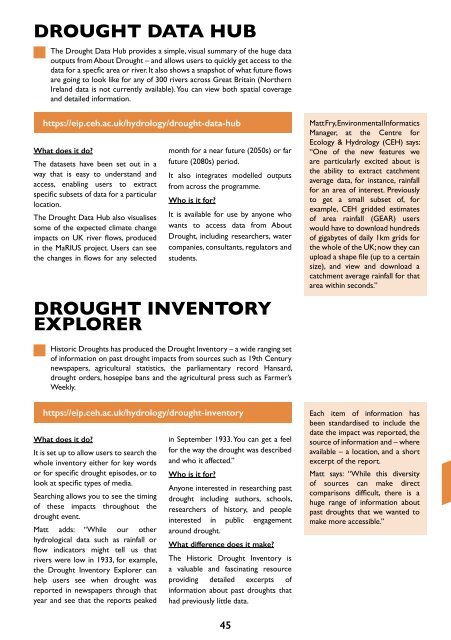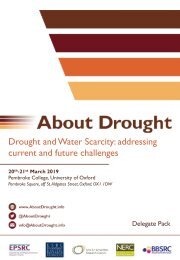About Drought Handbook: Outputs & Impacts
As the UK’s £12m Drought and Water Scarcity (DWS) research programme reaches its conclusion with a final event at The Royal Society in London, this handbook draws together the key outputs and outcomes. The book also features a series of interviews with our leading stakeholders, which highlight how successfully we have met our objectives to produce cutting-edge science that has made a demonstrable impact on how decision-makers manage water scarcity in the UK.
As the UK’s £12m Drought and Water Scarcity (DWS) research programme reaches its conclusion with a final event at The Royal Society in London, this handbook draws together the key outputs and outcomes. The book also features a series of interviews with our leading stakeholders, which highlight how successfully we have met our objectives to produce cutting-edge science that has made a demonstrable impact on how decision-makers manage water scarcity in the UK.
- No tags were found...
Create successful ePaper yourself
Turn your PDF publications into a flip-book with our unique Google optimized e-Paper software.
DROUGHT DATA HUB<br />
The <strong>Drought</strong> Data Hub provides a simple, visual summary of the huge data<br />
outputs from <strong>About</strong> <strong>Drought</strong> – and allows users to quickly get access to the<br />
data for a specfic area or river. It also shows a snapshot of what future flows<br />
are going to look like for any of 300 rivers across Great Britain (Northern<br />
Ireland data is not currently available). You can view both spatial coverage<br />
and detailed information.<br />
https://eip.ceh.ac.uk/hydrology/drought-data-hub<br />
What does it do?<br />
The datasets have been set out in a<br />
way that is easy to understand and<br />
access, enabling users to extract<br />
specific subsets of data for a particular<br />
location.<br />
The <strong>Drought</strong> Data Hub also visualises<br />
some of the expected climate change<br />
impacts on UK river flows, produced<br />
in the MaRIUS project. Users can see<br />
the changes in flows for any selected<br />
month for a near future (2050s) or far<br />
future (2080s) period.<br />
It also integrates modelled outputs<br />
from across the programme.<br />
Who is it for?<br />
It is available for use by anyone who<br />
wants to access data from <strong>About</strong><br />
<strong>Drought</strong>, including researchers, water<br />
companies, consultants, regulators and<br />
students.<br />
DROUGHT INVENTORY<br />
EXPLORER<br />
Matt Fry, Environmental Informatics<br />
Manager, at the Centre for<br />
Ecology & Hydrology (CEH) says:<br />
“One of the new features we<br />
are particularly excited about is<br />
the ability to extract catchment<br />
average data, for instance, rainfall<br />
for an area of interest. Previously<br />
to get a small subset of, for<br />
example, CEH gridded estimates<br />
of area rainfall (GEAR) users<br />
would have to download hundreds<br />
of gigabytes of daily 1km grids for<br />
the whole of the UK; now they can<br />
upload a shape file (up to a certain<br />
size), and view and download a<br />
catchment average rainfall for that<br />
area within seconds.”<br />
Historic <strong>Drought</strong>s has produced the <strong>Drought</strong> Inventory – a wide ranging set<br />
of information on past drought impacts from sources such as 19th Century<br />
newspapers, agricultural statistics, the parliamentary record Hansard,<br />
drought orders, hosepipe bans and the agricultural press such as Farmer’s<br />
Weekly.<br />
https://eip.ceh.ac.uk/hydrology/drought-inventory<br />
What does it do?<br />
It is set up to allow users to search the<br />
whole inventory either for key words<br />
or for specific drought episodes, or to<br />
look at specific types of media.<br />
Searching allows you to see the timing<br />
of these impacts throughout the<br />
drought event.<br />
Matt adds: “While our other<br />
hydrological data such as rainfall or<br />
flow indicators might tell us that<br />
rivers were low in 1933, for example,<br />
the <strong>Drought</strong> Inventory Explorer can<br />
help users see when drought was<br />
reported in newspapers through that<br />
year and see that the reports peaked<br />
in September 1933. You can get a feel<br />
for the way the drought was described<br />
and who it affected.”<br />
Who is it for?<br />
Anyone interested in researching past<br />
drought including authors, schools,<br />
researchers of history, and people<br />
interested in public engagement<br />
around drought.<br />
What difference does it make?<br />
The Historic <strong>Drought</strong> Inventory is<br />
a valuable and fascinating resource<br />
providing detailed excerpts of<br />
information about past droughts that<br />
had previously little data.<br />
Each item of information has<br />
been standardised to include the<br />
date the impact was reported, the<br />
source of information and – where<br />
available – a location, and a short<br />
excerpt of the report.<br />
Matt says: “While this diversity<br />
of sources can make direct<br />
comparisons difficult, there is a<br />
huge range of information about<br />
past droughts that we wanted to<br />
make more accessible.”<br />
45




